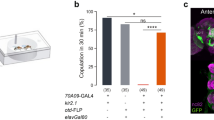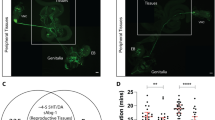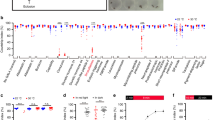Abstract
Robust innate behaviours are attractive systems for genetically dissecting how environmental cues are perceived and integrated to generate complex behaviours. During courtship, Drosophila males engage in a series of innate, stereotyped behaviours that are coordinated by specific sensory cues. However, little is known about the specific neural substrates mediating this complex behavioural programme1. Genetic, developmental and behavioural studies have shown that the fruitless (fru) gene encodes a set of male-specific transcription factors (FruM) that act to establish the potential for courtship in Drosophila2. FruM proteins are expressed in ∼2% of central nervous system neurons, at least one subset of which coordinates the component behaviours of courtship3,4. Here we have inserted the yeast GAL4 gene into the fru locus by homologous recombination and show that (1) FruM is expressed in subsets of all peripheral sensory systems previously implicated in courtship, (2) inhibition of FruM function in olfactory system components reduces olfactory-dependent changes in courtship behaviour, (3) transient inactivation of all FruM-expressing neurons abolishes courtship behaviour, with no other gross changes in general behaviour, and (4) ‘masculinization’ of FruM-expressing neurons in females is largely sufficient to confer male courtship behaviour. Together, these data demonstrate that FruM proteins specify the neural substrates of male courtship.
This is a preview of subscription content, access via your institution
Access options
Subscribe to this journal
Receive 51 print issues and online access
$199.00 per year
only $3.90 per issue
Buy this article
- Purchase on Springer Link
- Instant access to full article PDF
Prices may be subject to local taxes which are calculated during checkout




Similar content being viewed by others
References
Greenspan, R. J. & Ferveur, J. F. Courtship in Drosophila. Annu. Rev. Genet. 34, 205–232 (2000)
Baker, B. S., Taylor, B. J. & Hall, J. C. Are complex behaviors specified by dedicated regulatory genes? Reasoning from Drosophila. Cell 105, 13–24 (2001)
Lee, G. et al. Spatial, temporal, and sexually dimorphic expression patterns of the fruitless gene in the Drosophila central nervous system. J. Neurobiol. 43, 404–426 (2000)
Manoli, D. S. & Baker, B. S. Median bundle neurons coordinate behaviours during Drosophila male courtship. Nature 430, 564–569 (2004)
Ryner, L. C. et al. Control of male sexual behavior and sexual orientation in Drosophila by the fruitless gene. Cell 87, 1079–1089 (1996)
Gong, W. J. & Golic, K. G. Ends-out, or replacement, gene targeting in Drosophila. Proc. Natl Acad. Sci. USA 100, 2556–2561 (2003)
Keil, T. A. Fine structure of the pheromone-sensitive sensilla on the antenna of the hawkmoth, Manduca sexta. Tissue Cell 21, 139–151 (1989)
Boekhoff-Falk, G. Hearing in Drosophila: development of Johnston's organ and emerging parallels to vertebrate ear development. Dev. Dyn. 232, 550–558 (2005)
Ewing, A. W. The neuromuscular basis of courtship song in Drosophila: The role of direct and axillary wing muscles. J. Comp. Physiol. 130, 87–93 (1979)
Smith, S. A. & Shepherd, D. Central afferent projections of proprioceptive sensory neurons in Drosophila revealed with the enhancer-trap technique. J. Comp. Neurol. 364, 311–323 (1996)
Scott, K. C., Taubman, A. D. & Geyer, P. K. Enhancer blocking by the Drosophila gypsy insulator depends upon insulator anatomy and enhancer strength. Genetics 153, 787–798 (1999)
Spieth, H. T. Courtship behavior in Drosophila. Annu. Rev. Entomol. 19, 385–405 (1974)
Acebes, A., Cobb, M. & Ferveur, J. F. Species-specific effects of single sensillum ablation on mating position in Drosophila. J. Exp. Biol. 206, 3095–3100 (2003)
Wolfner, M. F. The gifts that keep on giving: physiological functions and evolutionary dynamics of male seminal proteins in Drosophila. Heredity 88, 85–93 (2002)
Billeter, J. C. & Goodwin, S. F. Characterization of Drosophila fruitless-gal4 transgenes reveals expression in male-specific fruitless neurons and innervation of male reproductive structures. J. Comp. Neurol. 475, 270–287 (2004)
Kondoh, Y., Kaneshiro, K. Y., Kimura, K. & Yamamoto, D. Evolution of sexual dimorphism in the olfactory brain of Hawaiian Drosophila. Proc. R. Soc. Lond. B 270, 1005–1013 (2003)
Vaias, L. J., Napolitano, L. M. & Tompkins, L. Identification of stimuli that mediate experience-dependent modification of homosexual courtship in Drosophila melanogaster. Behav. Genet. 23, 91–97 (1993)
Larsson, M. C. et al. Or83b encodes a broadly expressed odorant receptor essential for Drosophila olfaction. Neuron 43, 703–714 (2004)
Shyamala, B. V. & Chopra, A. Drosophila melanogaster chemosensory and muscle development: identification and properties of a novel allele of scalloped and of a new locus, SG18.1, in a Gal4 enhancer trap screen. J. Genet. 78, 87–97 (1999)
McBride, S. M. et al. Mushroom body ablation impairs short-term memory and long-term memory of courtship conditioning in Drosophila melanogaster. Neuron 24, 967–977 (1999)
Strauss, R. The central complex and the genetic dissection of locomotor behaviour. Curr. Opin. Neurobiol. 12, 633–638 (2002)
Acebes, A., Grosjean, Y., Everaerts, C. & Ferveur, J. F. Cholinergic control of synchronized seminal emissions in Drosophila. Curr. Biol. 14, 704–710 (2004)
Lee, G. & Hall, J. C. Abnormalities of male-specific FRU protein and serotonin expression in the CNS of fruitless mutants in Drosophila. J. Neurosci. 21, 513–526 (2001)
Anand, A. et al. Molecular genetic dissection of the sex-specific and vital functions of the Drosophila melanogaster sex determination gene fruitless. Genetics 158, 1569–1595 (2001)
Eberl, D. F., Duyk, G. M. & Perrimon, N. A genetic screen for mutations that disrupt an auditory response in Drosophila melanogaster. Proc. Natl Acad. Sci. USA 94, 14837–14842 (1997)
Liu, K. S. & Sternberg, P. W. Sensory regulation of male mating behavior in Caenorhabditis elegans. Neuron 14, 79–89 (1995)
Shah, N. M. et al. Visualizing sexual dimorphism in the brain. Neuron 43, 313–319 (2004)
Song, H. J. et al. The fruitless gene is required for the proper formation of axonal tracts in the embryonic central nervous system of Drosophila. Genetics 162, 1703–1724 (2002)
Kitamoto, T. Conditional disruption of synaptic transmission induces male–male courtship behavior in Drosophila. Proc. Natl Acad. Sci. USA 99, 13232–13237 (2002)
Goodwin, S. F. et al. Aberrant splicing and altered spatial expression patterns in fruitless mutants of Drosophila melanogaster. Genetics 154, 725–745 (2000)
Acknowledgements
The authors thank T. Clandinin and members of the Baker laboratory for discussions and comments on this manuscript, J. Sekelsky for the gift of the pWhiteOut2 vector, A. O'Reilly and M. Simon for technical advice, Y.-S. Liu for help with dissections, M. Siegal for help with statistics, and G. Bohm for preparation of culture materials and fly food. This work was supported by an NINDS grant to B.J.T., J.C.H. and B.S.B.
Author information
Authors and Affiliations
Corresponding author
Ethics declarations
Competing interests
Reprints and permissions information is available at npg.nature.com/reprintsandpermissions. The authors declare no competing financial interests.
Supplementary information
Supplementary Figure S1
This figure shows courtship index values (CI) for males with and without FruM function. (PDF 707 kb)
Supplementary Figure S2
This figure shows FruM expression in pharate males (a), where low levels of protein can be detected in regions previously not seen, as well as decreased numbers of cells in central brain clusters. (PDF 2912 kb)
Supplementary Figure S3
This figure shows fruP1-gal4, FruM, and fruP1-derived RNA in periperal structures. (PDF 4863 kb)
Supplementary Figure S4
This figure shows fruP1-gal4 expression in CNS components of the visual olfactory, and auditory systems. (PDF 4232 kb)
Supplementary Figure S5
This figure shows a female masculinized in fruP1-gal4 neurons displaying wing extension and vibration when a wild-type male in the chamber produces wing song. (PDF 658 kb)
Supplementary Video S1
This movie shows the behaviour of groups of control and fruP1-GAL4, UAS-shiTS males at restrictive temperatures (31C), illustrating that inhibition of synaptic transmission in fruP1-gal4 neurons does not appear to affects general behaviour in adult males. (MOV 2158 kb)
Supplementary Figures and Video Legends
Legends to accompany the above Supplementary Figures and Supplementary Video. (DOC 23 kb)
Rights and permissions
About this article
Cite this article
Manoli, D., Foss, M., Villella, A. et al. Male-specific fruitless specifies the neural substrates of Drosophila courtship behaviour. Nature 436, 395–400 (2005). https://doi.org/10.1038/nature03859
Received:
Accepted:
Published:
Issue Date:
DOI: https://doi.org/10.1038/nature03859
This article is cited by
-
A rapid and bidirectional reporter of neural activity reveals neural correlates of social behaviors in Drosophila
Nature Neuroscience (2023)
-
Female factors modulate Sex Peptide’s association with sperm in Drosophila melanogaster
BMC Biology (2022)
-
Sexually dimorphic peripheral sensory neurons regulate copulation duration and persistence in male Drosophila
Scientific Reports (2022)
-
Cholecystokinin/sulfakinin peptide signaling: conserved roles at the intersection between feeding, mating and aggression
Cellular and Molecular Life Sciences (2022)
-
Neural Control of Action Selection Among Innate Behaviors
Neuroscience Bulletin (2022)
Comments
By submitting a comment you agree to abide by our Terms and Community Guidelines. If you find something abusive or that does not comply with our terms or guidelines please flag it as inappropriate.



